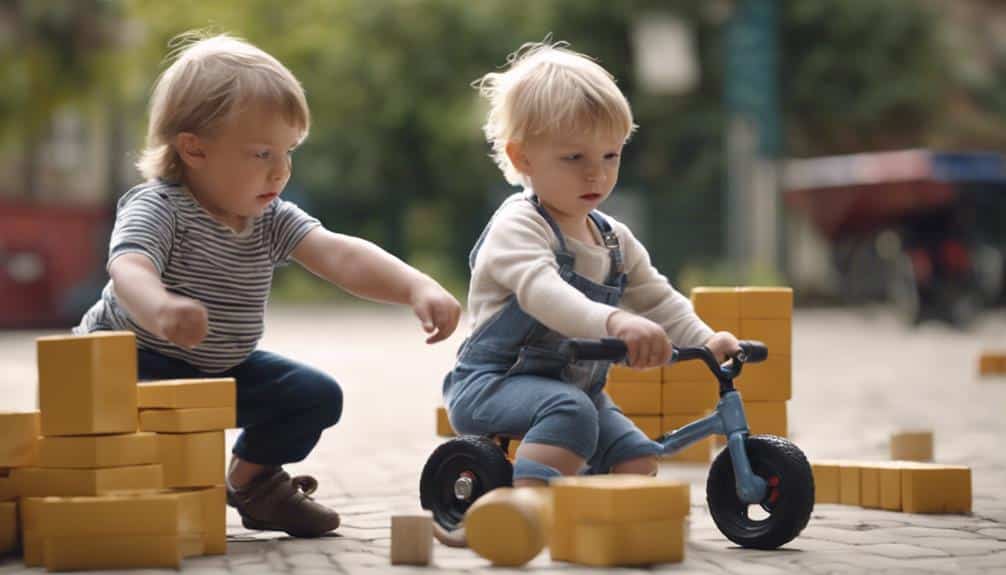Navigating developmental delays in young children involves recognizing significant lags in cognitive, physical, or social milestones critical for holistic development. Early identification is crucial, spotting signs like speech delays or missed physical milestones to provide necessary support. Causes vary from genetic conditions to traumatic brain injuries.
Essential screening tools enable early detection, facilitating timely interventions. Addressing delays requires a collaborative approach, integrating therapies and family support. Understanding signs and causes empowers caregivers to seek professional guidance, potentially optimizing their children’s development.
Key Takeaways
- Developmental delays manifest in speech, movement, social skills, and cognitive abilities.
- Early identification and intervention are crucial for improving a child’s developmental trajectory.
- Common causes include genetic conditions, environmental factors, and traumatic brain injuries.
- Screenings and evaluations are essential for diagnosing and planning interventions.
- Support for families and tailored therapies are crucial to managing developmental delays.
Navigating Developmental Delays
Understanding developmental delay involves recognizing when a child significantly lags behind their peers in achieving key cognitive, mental, or physical milestones, necessitating targeted interventions to support their holistic development. Developmental delays can manifest in various forms, including language, vision, movement, social, and thinking skills delays. These categories encapsulate the broad spectrum of challenges a child may face, each with its distinct impact on a child’s day-to-day functioning and overall growth.
Global developmental delay, a term used when significant lags are observed across multiple developmental areas, underscores the complexity and severity of some children’s situations. Unlike specific delays that might affect only one aspect of a child’s development, global developmental delay indicates a more extensive developmental hindrance, requiring a multidimensional approach to intervention.
It is essential to differentiate developmental delays from lifelong disabilities such as cerebral palsy or autism. While some developmental delays can be transient, children often catch up to their peers with the right early intervention services. These interventions target specific developmental milestones, offering a tailored approach to support each child’s needs. Emphasizing the significance of early detection and support, early intervention services play a pivotal role in maximizing a child’s potential for growth and development across all areas of delay.
Signs of Developmental Delays
Identifying signs of developmental delays early in a child’s growth is pivotal to ensuring they receive the necessary support and intervention. Speech delays and missed physical milestones, such as difficulties in walking or speaking, are critical indicators that a child may need further evaluation. By recognizing these signs, caregivers, and professionals can collaborate to foster a child’s development and help them achieve their fullest potential.
Recognizing Speech Delays
Recognizing speech delays in young children involves observing for signs such as insufficient age-appropriate babbling, gestures, or verbal expressions by expected developmental milestones. Speech delay, a common developmental issue, can manifest in various forms, including difficulty forming sounds, a limited vocabulary, or struggles to construct sentences. These difficulties may pertain to expressive language, where the child finds it challenging to convey thoughts, needs, or emotions, or receptive language, marked by a struggle to understand or respond to spoken cues.
Early intervention is vital in addressing speech delays, greatly enhancing communication skills through tailored speech therapy. This proactive approach ensures that young children receive the support they need to overcome obstacles in developing practical communication skills, fostering a stronger foundation for future learning and social interaction.
Physical Milestone Misses
While focusing on speech delays forms a foundational aspect of early childhood development, monitoring physical milestones as indicators of a child’s growth trajectory is equally vital. Missing key physical milestones can signal developmental delays and highlight underlying issues requiring attention. Observing a child’s gross and fine motor skills progress is critical to ensure they develop effectively. Persistent challenges in these areas can be red flags, necessitating a deeper evaluation by professionals to identify and address delays early.
| Age Milestone | Gross Motor Skills | Fine Motor Skills |
|---|---|---|
| Six months | Not rolling over | Difficulty grasping objects |
| Eight months | Not sitting up | Struggles with stacking blocks |
| 18 months | Not walking | Using utensils ineffectively |
Common Causes

Several factors, ranging from genetic conditions to environmental exposures, significantly contribute to developmental delays in young children. Genetic disorders like Down syndrome and Fragile X syndrome are significant contributors. These conditions, embedded in the very blueprint of a child’s biology, can affect their physical, cognitive, and social development. Similarly, premature birth and low birth weight are critical risk factors. Infants born before their systems have fully developed often face uphill battles in reaching developmental milestones on time.
Moreover, the environment in which a child is conceived and raised plays a pivotal role. Exposure to toxins, including lead and alcohol, during pregnancy can severely impair a child’s developmental progress. Such exposures, unfortunately, set the stage for challenges that may affect a child throughout their life.
Traumatic brain injuries resulting from accidents or abuse represent another cause of developmental delays. The impact of such injuries can be devastating, altering the course of a child’s development significantly. Lastly, the fundamentals of nutrition and prenatal care cannot be overstated. Inadequate nutrition and lack of quality prenatal care are preventable causes that nonetheless persist, underscoring the importance of thorough support systems for expecting mothers and young children to mitigate risks of developmental delays.
Diagnosis and Screening
Identifying early signs of developmental delays is essential for timely intervention, with screening tools and methods playing a pivotal role in the detection process. Through carefully interpreting screening results, healthcare providers can ascertain a child’s specific needs and recommend appropriate developmental support or interventions. This approach guarantees that children receive the help they need to reach their full potential, emphasizing the significance of early diagnosis and screening in fostering positive developmental outcomes.
Early Signs to Recognize
Recognizing the early signs of developmental delays—such as difficulties in rolling over, sitting up, crawling, and walking—is critical for initiating a timely diagnosis and screening process, thereby enabling prompt interventions. Early detection through developmental evaluation is essential in evaluating basic skills and identifying potential issues, which can lead to more effective support for the child.
- Delays in rolling over indicate potential gross motor skill development issues.
- Difficulties in sitting up are a sign of possible delays in core strength and balance.
- Challenges with crawling may highlight coordination or muscle strength concerns.
- Late walking potentially signals broader developmental or neurological concerns.
Regular developmental screenings can aid in the early detection of these signs, ensuring children receive the support and interventions needed to foster their growth and development.
Screening Tools and Methods
Screening tools and methods, such as the Ages and Stages Questionnaires (ASQ), play a pivotal role in the early identification of developmental delays in children, facilitating timely and appropriate interventions. These developmental screening approaches encompass parent questionnaires, professional direct observation, and standardized assessments, all designed to evaluate vital areas of development, including communication, motor skills, problem-solving abilities, and social interactions. Early screening identifies potential delays and sets the path for early intervention, maximizing the child’s developmental potential.
Pediatricians frequently employ these tools during well-child visits, ensuring a continuous monitoring of the child’s developmental trajectory. This proactive approach allows for early detection of developmental issues, promoting timely and tailored interventions for the child’s needs.
Interpreting Screening Results
Upon receiving screening results indicating potential developmental delays in young children, healthcare professionals must carefully interpret these findings to guide families toward appropriate interventions. The interpretation process is critical in identifying the specific areas needing support, such as language development, motor skills, and social interactions, to tailor early intervention strategies effectively.
- Expertise in Developmental Milestones: Understanding the typical milestones in child development is essential for accurate interpretation.
- Customized Intervention Plans: Based on the results, interventions can be specifically designed to address identified delays in language development, motor skills, or social interactions.
- Family Guidance and Support: Professionals provide essential support and guidance to families, helping them through the intervention process.
- Follow-up Assessments: Continuous monitoring and follow-up assessments ensure that interventions are adjusted as the child grows and develops.
Speech and Language Delays
Speech and language delays, often stemming from factors such as multilingual exposure, learning disabilities, or hearing impairments, represent a significant developmental concern that necessitates early and effective intervention. These delays can manifest in children as difficulty forming words, a limited vocabulary, and difficulty understanding language. The impact of speech and language delays extends beyond communication difficulties, affecting a child’s social interactions and academic achievements.
Early intervention is paramount in addressing these delays, with treatment options typically including speech therapy and engaging in daily communication activities designed to enhance linguistic skills. Speech therapists play a critical role in diagnosing the specific nature of the delay and tailoring interventions to meet each child’s needs. Children can make remarkable progress in developing practical communication skills through professional guidance and supportive home environments.
The essence of treating speech and language delays lies in directly improving speech and language abilities and bolstering a child’s confidence and social engagement. Identifying these delays early and pursuing appropriate treatment can significantly enhance a child’s overall developmental trajectory, underscoring the importance of vigilance and prompt action in the face of potential speech and language challenges.
Motor Skills Challenges

Motor skills challenges, encompassing coordination, balance, and movement control difficulties, significantly impact a child’s ability to navigate and interact with their environment. These challenges are barriers to physical activities, and critical learning experiences facilitated through movement. Early detection and intervention are crucial to helping children overcome these obstacles and achieve their developmental milestones.
The scope of motor skills challenges includes:
- Difficulties with considerable motor skills, such as walking and running, are essential for mobility and physical independence.
- Challenges with small motor skills, like grasping objects, are vital for tasks requiring fine motor coordination, such as writing and self-care activities.
- Underlying causes, such as genetic conditions, muscle issues, structural abnormalities, or brain injuries, necessitate a tailored intervention approach.
- The role of physical therapy in improving motor skills, highlighting the importance of specialized support and exercises designed to enhance movement control and coordination.
Addressing motor skills challenges involves a thorough understanding of each child’s individual needs and the implementation of targeted interventions. Through dedicated support, children can make significant progress in their motor skills, enhancing their ability to engage with their environment and participate fully in their development.
Social and Emotional Impact
Frequently overlooked, the social and psychological development of children with developmental delays is a vital aspect that profoundly influences their ability to form meaningful relationships and navigate social contexts. Social and psychological delays can manifest as difficulties interacting with others, hindering relationships. These children may face significant challenges in regulating emotions and expressing themselves, often resulting in behavioral challenges such as tantrums or aggression. The ripple effect of these issues affects their social interactions and ability to engage in play and learning activities effectively.
| Challenge | Impact | Need |
|---|---|---|
| Interacting with Others | Difficulty forming relationships | Early Intervention |
| Regulating Emotions | Prone to tantrums or aggression | Targeted Therapies |
| Expressing Themselves | Hindered communication skills | Supportive Environment |
| Behavioral Challenges | Disruptions in learning and play | Behavioral Interventions |
| Forming Relationships | Isolation from peers | Social Skills Training |
Early intervention and tailored therapies are essential in helping these children develop the vital skills needed for effective social interactions. Addressing these challenges early on can significantly improve their ability to connect with others and participate in social activities, laying a foundation for healthier social and psychological development.
Intervention Strategies

Addressing developmental delays in young children requires a multifaceted approach encompassing early identification and implementing personalized intervention strategies. Early identification allows for the timely initiation of targeted therapies, which is essential in mitigating the impacts of delays. Specialists can provide the most effective support by crafting customized intervention plans tailored to each child’s needs.
Critical components of successful intervention strategies include:
- Collaborating with a multidisciplinary team of professionals, including speech therapists, occupational therapists, and psychologists, to ensure a thorough approach to addressing the child’s developmental needs.
- Creating a supportive and enriching environment at home and in educational settings plays a significant role in the child’s growth and learning.
- Regular monitoring of the child’s progress is crucial for evaluating the effectiveness of the intervention strategies and making necessary adjustments.
- They are being prepared for adjustment to intervention plans based on the child’s response to therapies, ensuring that interventions remain aligned with evolving needs.
These strategies, characterized by their clinical precision and empathetic understanding, underscore the importance of a dynamic and responsive approach to intervention, ensuring that each child receives the support necessary to reach their full potential.
Support for Families
Exploring the journey of developmental delays in young children can be an overwhelming experience for families, requiring a thorough support system to foster resilience and understanding. Maneuvering the landscape of early childhood development, especially when faced with social and emotional, speech, or cognitive delays, necessitates a multifaceted approach to support. Support groups are essential, offering emotional backing and a platform for connection among families encountering similar challenges.
These groups, along with educational resources and workshops, equip families with crucial knowledge to better comprehend and meet their children’s needs.
Access to detailed information about available services, including occupational therapy and other interventions, is essential for families to support their child’s developmental progress effectively. Additionally, providing respite care services emerges as a vital component of supporting families, offering parents and caregivers the necessary break to prevent burnout and sustain their well-being.
Frequently Asked Questions
Can a 3-Year-Old With Developmental Delay Catch Up?
A 3-year-old with developmental delay can catch up with early intervention, personalized therapies, and parental involvement. Early identification and consistent efforts are essential, and progress varies per child, but significant improvements are possible with intervention.
What Is Developmental Delay in a Child?
Developmental delay in a child signifies a substantial lag in achieving expected developmental milestones. It encompasses cognitive, motor, social, affective, or speech delays, necessitating tailored interventions for best progress and early identification for effective management.
What Is a Developmental Delay in a 7-Year-Old?
A developmental delay in a 7-year-old can manifest across various areas, including academic skills, social and psychological abilities, motor skills, speech and language, and cognitive functions, impacting their overall learning and interaction capabilities.
What Are the Developmental Delays of a 4-Year-Old?
Addressing the elephant in the room, a 4-year-old may experience developmental delays in speech, motor skills, social interactions, and cognitive abilities. Early detection is essential for tailoring interventions that support best growth and development.
Conclusion
Developmental delays in young children are a complex issue that requires a collaborative approach from health professionals, caregivers, and parents. Social skills, language skills, and cognitive skills are some of the areas that children with developmental disabilities may struggle with. Early evaluation and timely intervention services are crucial in mitigating potential delays. Intervention programs such as speech, physical, and pediatric occupational therapy can help children with disabilities learn adaptive behaviors and problem-solving skills. Positive reinforcement and regular assessments can help track the child’s developmental outcome.
Parents of children with developmental challenges play a pivotal role in the child’s comprehensive care. Maternal education, birth weight, and complications during pregnancy are some of the environmental factors that can affect child development. Age-appropriate toys and physical activities can foster cognitive development and social engagement. A supportive environment and collaborative environment among healthcare professionals can help families of children with disabilities access specialized services such as DIRFloortime, Play-based therapy, and alternative therapies.
Studies have shown that comprehensive care at the primary care level can improve long-term outcomes for children with disabilities. Collaboration with specialists and community resources can provide valuable insights into the child’s learning styles and behavior. Healthcare providers can use clinical interventions such as visual schedules and two-word phrases to improve communication skills and social interaction. Children from birth to 36 months of age sample at child age can benefit from early intervention programs, especially those with genetic conditions such as Muscular Dystrophy, cerebral palsy, and intellectual disabilities.
In conclusion, a comprehensive evaluation of the child’s developmental issue is the first step toward improving outcomes for children with disabilities. Health professionals, parents, and caregivers can work together to create a conducive learning environment fostering age-appropriate and positive behaviors. Regular assessments, collaborative efforts, and psychological resources can help reduce levels of parenting stress and improve parenting efforts. The relation between child behavior and academic performance is crucial in determining the child’s future.


Recent Comments